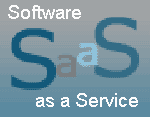 |
 |
SaaS Solutions Surge
By : Jim Pinto, Why are huge hunks of software still installed on individual computers as though they were isolated lumps of hardware? Today, everything is networked and Software has become a Service. So software installations with traditional End User License Agreements (EULA) are obsolete. Why go stale? Go SaaS!
March 2009
|
 "The Network is the Computer." That phrase became Sun Microsystems Inc.s slogan, and that vision has become truer over time. And yet, why are huge hunks of software still installed on individual computers as though they were isolated lumps of hardware?
"The Network is the Computer." That phrase became Sun Microsystems Inc.s slogan, and that vision has become truer over time. And yet, why are huge hunks of software still installed on individual computers as though they were isolated lumps of hardware?
If you're isolated somewhere with no Internet connection, you might need several software packages installed on your computer. But these days, that happens rarely because connections are as ubiquitous as cell-phone service. At the enterprise level, everything is networked. So software package installations with traditional End User License Agreements (EULA) are obsolete. Widely used operating systems such as Microsoft Windows require regular upgrades for improved security and bug fixes, and these typically arrive automatically via the network. When you're online, have you noticed how your computer is commandeered suddenly by Windows, or by anti-virus or Java updates? If the user is not present when the update install-prompt arrives, the software takes over and does a self-install. On returning, the user finds that all open applications have been exited and the computer has been mysteriously re-booted. There is virtually no software that is immune from this dreaded update disease. Virus-protection software such as Symantec or McAfee cannot be sold as one-install packages because protection must be updated constantly to protect against the latest virus dangers that arrive constantly. Indeed, when any licensed computer is booted up, it automatically keeps checking for updates. Installed software typically requires users to have a fully paid license per computer. To work at home, or at a different location, the remote license is useless. Installation processes for large packages could be complex and time-consuming. In addition, moving to a new computer involves several software package installations - and then there's the update and bug fix catch-up. How many terabytes of packaged software remain dormant on how many computers? Software as a Service (SaaS, typically pronounced "sass") is here, and it's the wave of the future. SaaS is a software deployment model in which enterprise applications are delivered and managed as services to meet the needs of multiple customers simultaneously. Applications are licensed for use on demand, removing the cost and burden of installed software on every computer. This greatly reduces the ongoing maintenance required for conventional "full" installations, and facilitates central control of all updates and upgrades. Reduced investmentSuppliers establish an ongoing revenue stream using centralized control, offering flexibility without the complexity and high initial cost of equipping computers that may be used only occasionally. On-demand licensing makes usage a variable expense, typically far less than traditional up-front, per-user pricing. In addition, it reduces user investments in server hardware.The distinction from complete applications delivered over the Internet is that SaaS solutions are developed specifically to leverage browsers, making them "Web-native." The design and architecture of SaaS applications are specifically built to enable multiple users to access a shared-data model. SaaS shifts the burden of installation and keeping an application up-and-running from the user to the supplier. Users can leverage rapid functionality without additional staff resources. Enterprise customers benefit from the vendor's latest technological features, without the disruptions and costs associated with software updates and upgrades. SaaS providers leverage economies of scale in management and customer support through software development lifecycles. Saas-delivered software enables end-users to deploy automation more quickly, experience more predictable costs and achieve a faster return on investment (ROI). Studies have demonstrated ROI within in six months or less, typically two to four times faster than fully installed EULA alternatives. Why go stale? Go SaaS! 
|
 Pinto's Points How to win in the Automation Business Go shopping - books, electronics, CD/DVD Selected advertising coming here. Contact Jim Pinto for rates. |
Return to Index of all JimPinto Writings

 Return to JimPinto.com HomePage
Return to JimPinto.com HomePage
If you have ideas or suggestions to improve this site, contact: webmaster@jimpinto.com
Copyright 2006 : Jim Pinto, San Diego, CA, USA
